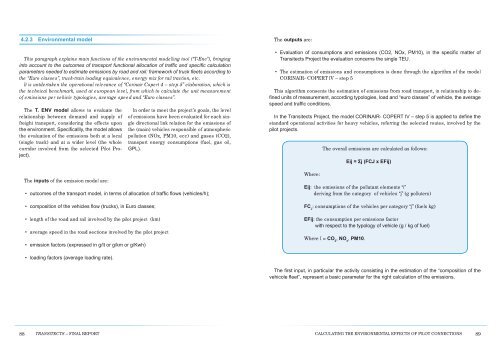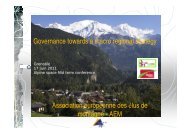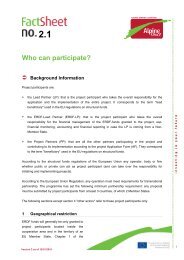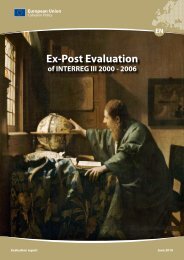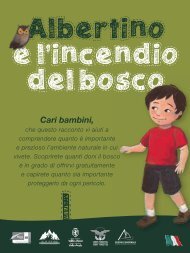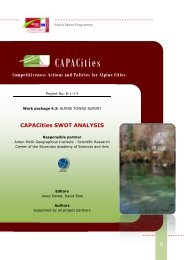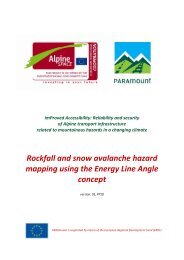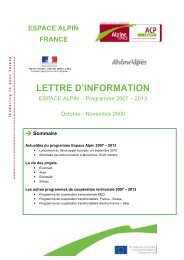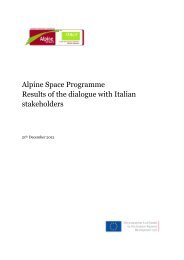intermodal solutions for transalpine freight traffic - Alpine Space ...
intermodal solutions for transalpine freight traffic - Alpine Space ...
intermodal solutions for transalpine freight traffic - Alpine Space ...
Create successful ePaper yourself
Turn your PDF publications into a flip-book with our unique Google optimized e-Paper software.
4.2.3 environmental model<br />
This paragraph explains main functions of the environmental modelling tool (“T-Env”), bringing<br />
into account to the outcomes of transport functional allocation of <strong>traffic</strong> and specific calculation<br />
parameters needed to estimate emissions by road and rail: framework of truck fleets according to<br />
the “Euro classes”, truck-train loading equivalence, energy mix <strong>for</strong> rail traction, etc.<br />
It is untdertaken the operational relevance of “Corinair Copert 4 – step 5” elaboration, which is<br />
the technical benchmark, used at european level, from which to calculate the unit measurement<br />
of emissions per vehicle typologies, average speed and “Euro classes”.<br />
The T. env model allows to evaluate the<br />
relationship between demand and supply of<br />
<strong>freight</strong> transport, considering the effects upon<br />
the environment. Specificallly, the model allows<br />
the evaluation of the emissions both at a local<br />
(single track) and at a wider level (the whole<br />
corridor involved from the selected Pilot Project).<br />
The inputs of the emission model are:<br />
In order to meet the project’s goals, the level<br />
of emissions have been evaluated <strong>for</strong> each single<br />
directional link relation <strong>for</strong> the emissions of<br />
the (main) vehicles responsible of atmospheric<br />
pollution (NOx, PM10, ecc) and gases (CO2),<br />
transport energy consumptions (fuel, gas oil,<br />
GPL).<br />
• outcomes of the transport model, in terms of allocation of <strong>traffic</strong> flows (vehicles/h);<br />
• composition of the vehicles flow (trucks), in Euro classes;<br />
• length of the road and rail involved by the pilot project (km)<br />
• average speed in the road sections involved by the pilot project<br />
• emission factors (expressed in g/lt or g/km or g/Kwh)<br />
The outputs are:<br />
• Evaluation of consumptions and emissions (CO2, NOx, PM10), in the specific matter of<br />
Transitects Project the evaluation concerns the single TEU.<br />
• The estimation of emissions and consumptions is done through the algorithm of the model<br />
CORINAIR- COPERT IV – step 5<br />
This algorithm consents the estimation of emissions from road transport, in relationship to defined<br />
units of measurement, according typologies, load and “euro classes” of vehicle, the average<br />
speed and <strong>traffic</strong> conditions.<br />
In the Transitects Project, the model CORINAIR- COPERT IV – step 5 is applied to define the<br />
standard operational activities <strong>for</strong> heavy vehicles, referring the selected routes, involved by the<br />
pilot projects.<br />
Where:<br />
The overall emissions are calculated as follows:<br />
Eij = Σj (FCJ x EFij)<br />
Eij: the emissions of the pollutant elements “i”<br />
deriving from the category of vehicles “j” (g polluters)<br />
fC j<br />
: consumptions of the vehicles per category “j” (fuels kg)<br />
EFij: the consumption per emissions factor<br />
with respect to the typology of vehicle (g / kg of fuel)<br />
Where I = Co 2<br />
, no x<br />
, Pm10.<br />
• loading factors (average loading rate).<br />
The first input, in particular the activity consisting in the estimation of the “composition of the<br />
vehicole fleet”, represent a basic parameter <strong>for</strong> the right calculation of the emissions.<br />
88 transitects – final report<br />
CalCulating the environmental effeCts of pilot ConneCtions<br />
89


